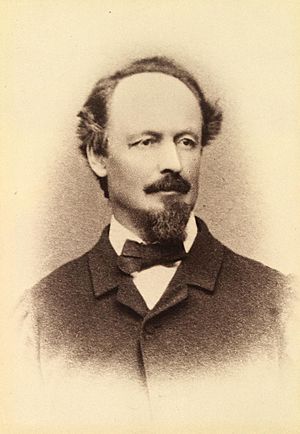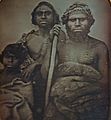Douglas Kilburn facts for kids
Quick facts for kids
Douglas Thomas Kilburn
|
|
|---|---|

Douglas Kilburn photographed in 1850
|
|
| Born | 1813 |
| Died | 10 March 1871 (aged 57–58) |
| Nationality | British |
| Education | autodidact |
| Known for | Photography, Painting |
| Spouse(s) | Anna Maria (née Patterson) |
| Awards | 1955: Honourable Mention, Exposition Universelle (1855), Paris |
Douglas Thomas Kilburn (born 1813, died 1871) was an artist from England. He was known for his watercolour paintings and for being a professional photographer. He worked in Melbourne, Australia, from 1847 to 1849. He took some of the very first portrait photos of Aboriginal Australians.
| Top - 0-9 A B C D E F G H I J K L M N O P Q R S T U V W X Y Z |
Early Life and Photography Beginnings
Douglas Kilburn was born in London, England, in 1813. He trained to be an artist. His younger brother, William, was already a successful photographer in London. William even took photos for Prince Albert, a member of the British Royal Family.
Douglas moved to Australia before 1847. His brother William sent him photography equipment and supplies from England. The brothers also worked together as agents for customs and shipping for a short time.
Photography in Australia
Setting Up in Melbourne
In 1847, Kilburn announced that he would soon be taking "likenesses" (portraits) using the Daguerreotype process. This was an early type of photography. He planned to set up a special room in Melbourne. This room would soften the bright daylight. This way, people posing for photos would not have to deal with harsh sunlight.
Early Photos of Aboriginal People
Around 1847-1848, Kilburn took some of the earliest surviving daguerreotypes of Aboriginal Australians. These photos are a very important historical record. He photographed Boon Wurrung people from the Yalukit clan. These groups lived around the Yarra River and Port Phillip Bay, near where Melbourne was founded.
Another photographer, Thomas Browne, also took early photos of Aboriginal people in Tasmania. It is not clear who took the very first ones.
Kilburn's photos were used by other artists and writers. For example, William Westgarth used engravings made from Kilburn's photos in his book about Australia. The famous newspaper The Illustrated London News also published engravings of these photos in 1850.
The newspaper explained that Kilburn had trouble convincing people to pose. They had a fear that it would bring them bad luck. He offered small gifts to persuade them. He kept traditional possum-skin cloaks for them to wear. This was because he wanted to show them in traditional ways, even though they were starting to wear European clothes.
Four of Kilburn's original daguerreotype plates of Aboriginal people still exist today. Three are at the National Gallery of Victoria and one is at the National Gallery of Australia. They show groups of men, women, and a family. Even though Kilburn had to persuade them, the people in the photos look proud and strong.
Reactions to the Portraits
William Westgarth, who used Kilburn's images in his book, said they were "very accurate pictures of the Australian natives."
However, some people at the time had sad views about Aboriginal people. One reviewer of Westgarth's book felt that Aboriginal people could not improve their situation.
Today, First Nations people have different views on these photos. Brenda L. Croft, an Aboriginal artist, has written about them. She notes that the people in the photos look confident. She feels their gaze challenges the old idea that their people were dying out. Croft also asks why the names of the photographers are known, but the names of the people photographed are not. She feels a "sense of loss" because of this. She believes these people should be remembered as individuals and community members.
Studios in Melbourne and Sydney
In May 1848, Douglas Kilburn opened a daguerreotype studio in Little Collins Street, Melbourne. It was one of the first photography studios in the city. The Argus newspaper praised his work. They said his photos were very lifelike and clear.
In 1849, Kilburn moved to Sydney. There, he made hand-coloured portraits of European settlers. The Sydney Morning Herald newspaper said these were the best photos in Australia at the time.
Life in Tasmania
Kilburn briefly visited Britain in 1850 to learn about new photography methods. While there, he married Anna Maria. They then settled in Hobart, Tasmania.
In Tasmania, Kilburn gave the first scientific talks on photography in Australia. He spoke about stereoscopy (creating 3D images) in 1853 and calotype photography in 1855. He wanted to encourage others to learn photography.
His calotype photos of Hobart won an award at the 1855 Paris Universal Exhibition. Kilburn became quite successful from his photography businesses. He bought several properties in Hobart.
Kilburn also became involved in public life. He served as a Justice of the Peace and a Magistrate. In 1854, he entered politics and became a Member of Parliament in Tasmania. He served until 1862. In this role, he supported the local army and spoke about public spending.
He later retired from parliament and worked for Argus newspaper in Melbourne. He returned to Tasmania around 1870.
Douglas Kilburn died in Hobart on March 10, 1871. He was buried in St David's Park. He was survived by his wife, Anna Maria, and their four children.
Exhibitions
- 1854: Tasmanian Contributions To The Paris Exposition. Exhibition Building, Hobart.
- 1855: Calotype Views: Bank of Australasia, Macquarie Street Hobart Town with St. Joseph's Church in the distance; New Market Place, Hobart Town; Residence of D.T. Kilburn, Esq., Davey Street, Hobart Town; St. David's Church, Macquarie Street, Hobart Town; St. Joseph's Church, Macquarie Street, Hobart Town, with St. David's in the distance. Paris Universal Exhibition.
- 1858: Aborigines (4 photographs). Art-Treasures Exhibition, Legislative Chamber, Hobart Town.
Collections
- Australian National Gallery
- National Gallery of Victoria
Gallery





